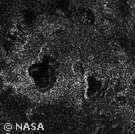Saturday, October 14, 2006
Exobiology: Slushy volcanoes might support life on Titan
 Dozens of structures on Saturn's moon Titan that appear to be collapsed slush volcanoes have been revealed by NASA's Cassini spacecraft. The heat and chemicals associated with these possible volcanoes could provide a niche for life on the frigid moon.
Dozens of structures on Saturn's moon Titan that appear to be collapsed slush volcanoes have been revealed by NASA's Cassini spacecraft. The heat and chemicals associated with these possible volcanoes could provide a niche for life on the frigid moon.
Figuring out whether Titan is volcanically active is important because volcanoes could be a source of the methane found in relatively large amounts in the moon's atmosphere. The methane is constantly being broken down by sunlight, so it must be replenished somehow.
In a flyby of the moon on 22 July, radar observations revealed dozens of rounded depressions that look like volcanic structures on Earth called calderas. These depressions form on Earth when the ground collapses after lava has drained out from under it in volcanic eruptions. [Science, Astronomy, Space, Volcano, Evolution, Caldera]
Continued at "Exobiology: Slushy volcanoes might support life on Titan"
-------
Featured book: "Astrobiology: A Brief Introduction" (Amazon UK | US)
Technorati: saturn, moon, titan, slush, volcanoes, nasa, cassini, spacecraft, active, niche, life, frigid, methane, atmosphere, flyby, radar, observations, volcanic, structures, earth, calderas, lava, eruptions, science, astronomy, space, volcano, evolution, caldera, exobiology, life, support, heat, chemicals
Add to: CiteUlike | Connotea | Del.icio.us | Digg | Furl | Newsvine | Reddit | Yahoo